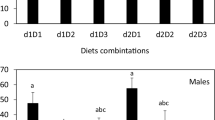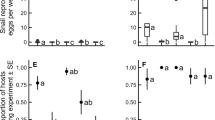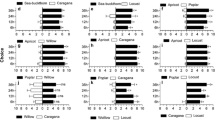Summary
Previous work has shown that host choice by acridids (grasshoppers and locusts) is sensitive to alterations in host quality. In particular, reduced plant water content has been found to increase palatability of certain plant species. To determine if this phenomenon is general, and to gain preliminary information on causes, turgid and wilted plant material of forty-one species was tested using nymphs of the desert locust, Schistocerca gregaria. Twelve plant species (29%) had increased and five (12%) had decreased palatability (as measured by meal size) when wilted. Among fifteen families tested, the increases occurred in six, the decreases in three. The greatest change occurred in Taraxacum officinale; further tests on this plant revealed the increase to be continuous, rising with decreasing water content. The behavioral observations combined with the pattern of the results across plant species suggest that changes are due to alterations in specific deterrents or stimulants, rather than to decreased water content or increased concentrations of amino acids and/or sugars. The implications of these results for understanding drought-associated population outbreaks are discussed.
Similar content being viewed by others
References
Bernays E, Chapman R, Leather E, McCaffery A, Modder W (1977) The relationship of Zonocerus variegatus (Acridoidea: Pyrgomorphidae) with cassava (Manihot esculenta). Bull Ent Res 67:391–404
Bokhari U, Trent J (1985) Proline concentrations in water stressed grasses. J Range Mgmnt 38:37–38
Cook A (1977) Nutrient chemicals as phagostimulants for Locusta migratoria (L.) Ecol Entomol 2:113–121
Crawley M (1983) Hervivory: the dynamics of animal-plant interactions. University of California Press, Berkeley
Levitt J (1980) Responses of plants to environmental stress, vol. II: water, radiation, salt and other stresses. Academic Press, New York
Lewis A (1982)a Conditions of feeding preference for wilted sunflower in the grasshopper Melanoplus differentialis. In: Visser J, Minks A (eds) Proc 5th int. symp. insect-plant relationships. Pudoc, Wageningen, pp 49–56
Lewis A (1982b) Leaf wilting alters a plant species ranking by the grasshopper Melanoplus differentialis. Ecol entomol 7:391–395
Lewis A (1984) Plant quality and grasshopper feeding: effects of sunflower condition on preference and performance in Melanopls differentialis. Ecol 65:836–843
Lewis A, Bernays E (1985) Feeding behavior: selection of both wet and dry food for increased growth in Schistocerca gregaria nymphs. Entomol Exp Appl 37:105–112
Lewis A, Emden H van (1986) Bioassays for insect feeding. In: Miller T, Miller J (eds) Techniques in plant-insect interactions. Springer, Berlin Heidelberg New York (in press)
Rees S, Harborne J (1985) The role of sesquiterpene lactones and phenolics in the chemical defence of the chicory plant. Phytochem 24:2225–2231
Rhoades D (1979) Evolution of plant chemical defenses against herbivores. In: Rosenthal G, Janzen D (eds) Herbivores: their interaction with secondary plant metabolites. Academic Press, New York, pp 1–48
Risch S (1985) Effects of induced chemical changes on interpretation of feeding preference tests. Entomol Exp Appl (in press)
Stewart G, Lahrer M (1980) Accumulation of amino acids and related compounds in relation to environmental stress. In: The biochemistry of plants, vol 5. Academic Press, London, pp 609–635
White TCR (1976) Weather, food and plagues of locusts. Oecologia (Berlin) 22:119–134
White TCR (1984) The abundance of invertebrate herbivores in relation to the availability of nitrogen in stressed food plants. Oecologia (Berlin) 63:90–105
Woodhead S (1982) p-hydroxybenzaldehyde in the surface wax of sorghum and its importance in seedling resistance to acridids. Entomol Exp Appl 31:296–302
Woodhead S, Bernays E (1977) Changes in release rates of cyanide in relation to palatability of Sorghum to insects. Nature 270:235–236
Author information
Authors and Affiliations
Rights and permissions
About this article
Cite this article
Bernays, E.A., Lewis, A.C. The effect of wilting on palatability of plants to Schistocerca gregaria, the desert locust. Oecologia 70, 132–135 (1986). https://doi.org/10.1007/BF00377122
Received:
Issue Date:
DOI: https://doi.org/10.1007/BF00377122




